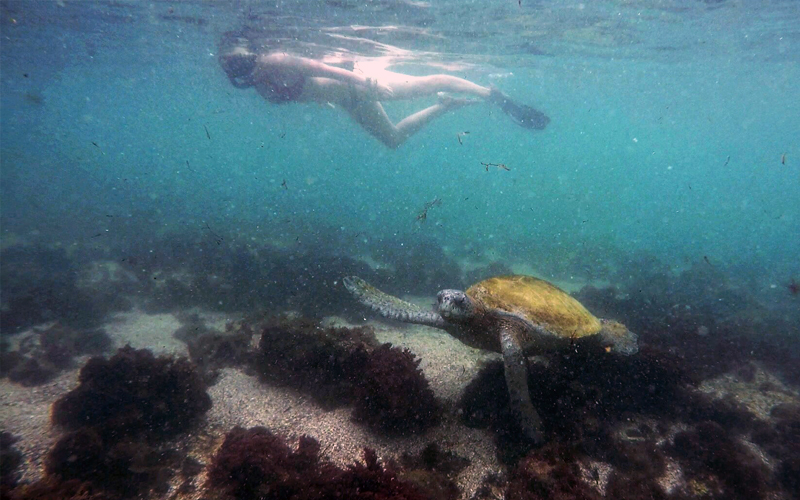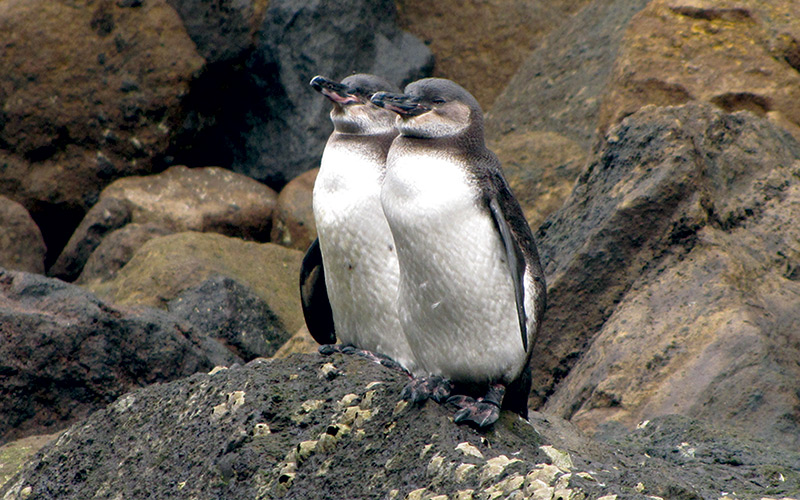The Galapagos Islands are well-known as a worldwide mecca for scuba divers, but what is often lost is the fact that you don’t need to be SCUBA certified to enjoy the dazzling marine wildlife: snorkeling is a great way to see the wonders of the sea and is enjoyable for all ages!

What Might You See
Galapagos is teeming with marine life and a lucky snorkeler might have a close encounter with anything from a hammerhead shark to a penguin, an octopus to a diving booby or sea lion. Almost all snorkelers are certain to see many common reef fish, such as parrot fish, brightly colored wrasses and schools of surgeonfish. Stingrays are very common: look for them in sandy areas near the shore. Sea turtles are also a common sight: the best way to increase your chance of seeing one is to look for seaweed beds where they might be feeding.
Lucky snorkelers will see white-tipped reef sharks, the most common in Galapagos, in deeper waters. Spotted eagle and manta rays also like deeper waters. Sharp-eyed snorkelers might see one of several varieties of disguised fish such as frogfish and scorpion fish blending into their colorful surroundings.
What You Need to Know
Galapagos features numerous sites for snorkeling, some easy and some challenging. Many islands offer off-the-shore snorkeling: this is the easiest, as you can come and go if you get tired and the currents aren’t a factor. Unfortunately, close to a sandy shore is likely to offer the least variety of marine life, although you may also get lucky and spot a sea lion or some rays.

Protected wall swims are best for intermediate snorkelers. Many islands have a cliff where they met the water, as opposed to a sloping, sandy beach. Islands with good places to snorkel along the wall are Rabida, Isabela and Genovesa. These walls are largely protected from currents and winds, and you can see a wide variety of sea life off of one of the walls.
Deep-water rocks are best for very good swimmers. In some places around Galapagos, there are isolated rocks in the middle of the ocean, such as Devil’s Crown, Turtle Rock and Kicker Rock. You can get near the rocks and swim around them, often seeing some fantastic wildlife such as sharks, rays, eels, large fish and more. These sites are known for strong currents and the water is often cooler than it is closer to shore.

Gear
Most ships provide snorkeling gear – fins, mask and snorkel – and have wetsuits for rent. The range of sizes and quality of the equipment can depend on the specific cruise, but in general the more luxurious the boat, the better the gear they have to offer. With fins, generally up to a size 12 or 13 men’s are offered on the boat. If your feet are much larger, you may want to pack your own.
Your mask should be snug but not too tight. The ideal mask keeps the water out but won’t give you a headache from squeezing your head. It should have a rubber or silicone covering for the nose and feel fairly comfortable when it is on.
If you decide to bring your own gear, give it a test before your trip to make necessary adjustments and become familiar with its fit. There are a variety of snorkel options: the fancier ones are worth a look, as they do a better job of allowing you to breathe and keeping water out. Ask your travel agent about the equipment provided on your cruise.

Tips
- Talk to your guides before going.
- Ask them what to wear and what to look for.
- Take their advice seriously: if you’re not a good swimmer, you have no business swimming around Devil’s Crown.
- When snorkeling, stick close, as sharp-eyed guides will be able to point out things you may have missed.
- If you have an underwater camera, be sure to bring it. Galapagos has many wonderful opportunities for underwater photographers.
The Galapagos Sea Lion is the largest earth mammal of the Enchanted Islands, and probably the most playful of them all, if you have the chance to visit the islands you will find
The Galapagos Islands are well known as a worldwide mecca for scuba divers, but what is often lost is the fact that you do not need to be SCUBA certified to enjoy the dazzling marine wildlife. Snorkeling is a great way to see the wonders of the sea and is enjoyable for all age.
The Galapagos is teeming with marine life and a lucky snorkeler might have a close encounter with anything from a hammerhead shark to a penguin, an octopus to a diving booby or sea lion.

Almost all snorkelers are certain to see many common reef fish, such as parrotfish, brightly colored wrasses and schools of surgeonfish. Stingrays are very common. Look for them in sandy areas near the shore. Sea turtles are also a common sight. The best way to increase your chance of seeing one is to look for seaweed beds where they might be feeding.
Lucky snorkelers will see white-tip reef sharks, the most common in the Galapagos, in deeper waters. Spotted eagle and manta rays also like deeper waters. Sharp-eyed snorkelers might see one of several varieties of disguised fish such as frogfish and scorpion fish blending into their colorful surroundings.
It is your turn to be dazzled by the superb underwater life in the Galapagos! Ask one of our knowledgeable trip advisors about snorkeling on your cruise. Begin planning your once-in-a-lifetime Galapagos adventure today.
If you have an underwater camera, be sure to bring it. The Galapagos has many wonderful opportunities for underwater photographers.

